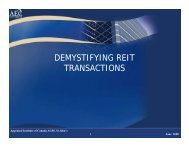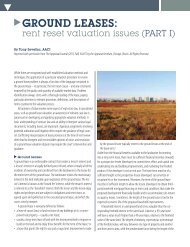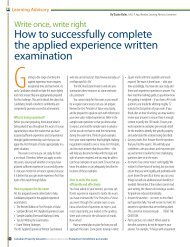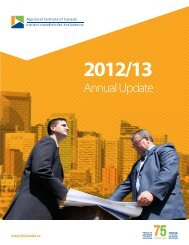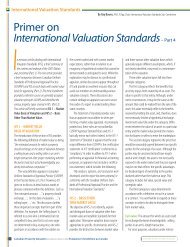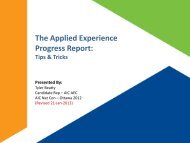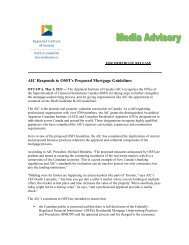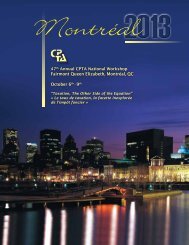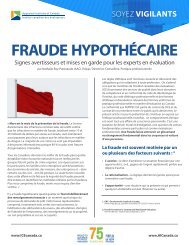Book 4 - Appraisal Institute of Canada
Book 4 - Appraisal Institute of Canada
Book 4 - Appraisal Institute of Canada
You also want an ePaper? Increase the reach of your titles
YUMPU automatically turns print PDFs into web optimized ePapers that Google loves.
the marketplace, and her grasp <strong>of</strong> concepts suchas depreciation and site-specific versus massappraisal valuation.Kotchon found his combination <strong>of</strong> educationand experience to be equally helpful in preparingfor the transition from appraisal to assessmentwork. The provincial assessors associationrecognized this as well. “Because I had an AACI,the Alberta Assessors’ Association granted menumerous exemptions relative to courses andexperience requirements,” explains Kotchon. “Iended up having to take only one general coursein assessment tools and legislation.”Similarly, when Dubeau was hired by theCity <strong>of</strong> Medicine Hat five years ago, she put touse the combined skills and knowledge <strong>of</strong> aproperty assessor and a CRA, including collectingdata, understanding land uses, taking information<strong>of</strong>f new plans and doing site inspectionsfor condominiums, multi-family homes, mobilehomes, farmland and vacant land. She points outthat she finds her appraisal background to be <strong>of</strong>particular advantage in her work.“As an assessor, you have this wide range <strong>of</strong>knowledge that is difficult to present in a way thatthe typical taxpayer will understand,” she explains,adding that, when taxpayers come in to challengean assessment, it is important to treat them withcompassion and empathy. “That is when I put onmy appraiser hat to see it from their point <strong>of</strong> viewand as an appraiser would.” Having gone throughthis process with them, she then finds it easier tomove on to explaining the assessor’s point <strong>of</strong> viewand the need to be fair and equitable in comparisonwith other properties.This straddling <strong>of</strong> perspectives is equallyimportant when Dubeau and Kotchon representtheir respective municipalities at the AssessmentReview Board. It plays an important role inequipping the assessors to deal with a potentiallyconfrontational situation.Kotchon finds that his experience as an expertwitness representing his former employer (Revenue<strong>Canada</strong>) in the tax court <strong>of</strong> <strong>Canada</strong> has alsobeen useful. “You not only have to come up witha value, but make sure it is defendable in a courtproceeding,” he notes. This applies not only toKotchon, but also to the two assessors who workunder him and to those working in the residentialsector. Each assessor gets a turn at going intocourt. The more experienced assessors get thecomplex cases, while the less complex cases areused as an opportunity to ease new assessorsinto this aspect <strong>of</strong> the job.At the time Kotchon was hired, the City <strong>of</strong>Red Deer also hired another AACI who was aformer fee appraiser. “She is working with meand I am helping her make the transition to thepublic sector,” he says. “It is always more <strong>of</strong> anadaptation for a fee appraiser, however, I thinkshe is really enjoying it.”One adjustment that both AACIs have sharedis the need to think about current value ratherthan value at a fixed point in the past. “When Iwas with Revenue <strong>Canada</strong>, I was working mainlyin the past,” confirms Kotchon. “It is very differentdealing with historical information whereyou know exactly what happened in the market.With assessments, you are always looking atwhat is happening in the current market andtrying to anticipate the future.”Equipping appraisers to appreciate the differencesbetween assessing and appraising is a needthe <strong>Appraisal</strong> <strong>Institute</strong> <strong>of</strong> <strong>Canada</strong> has recognized asappraisers are increasingly finding their way intothe assessment field. “When I was going throughthe designation process, there was no talk <strong>of</strong> theassessment portion <strong>of</strong> valuation,” notes Kotchon.“That is now being addressed in order to giveAACIs an even more well-rounded education.”He adds that this move comes at a time whenthere will likely be more opportunities than everfor appraisers to find work in the assessmentfield. “A lot <strong>of</strong> experienced people are retiring,”he says. “I think there are significant opportunitiesavailable to Candidate students who arelooking at a career in the valuation pr<strong>of</strong>ession.”In the year and a half that he has been in hisnew position, a number <strong>of</strong> his colleagues havemoved on to higher positions with the City <strong>of</strong>Lethbridge, which has left several openings inRed Deer. In the last six months, Red Deer hashired two new assessors, including anotherformer fee appraiser with a background inresidential valuation.In Dubeau’s Medicine Hat assessmentdepartment, five <strong>of</strong> the 12 assessors – includingDubeau herself – will be retiring over the nexttwo years. “I am sure other jurisdictions are in thesame situation,” she says.Assessment departments in these municipalitieswill soon be looking for employees witha solid understanding <strong>of</strong> valuation. Althoughappraisers have the necessary precepts, theycan further prepare for entering this field byfamiliarizing themselves with the legislationthat governs assessments in a particular jurisdiction.Strong interpersonal communicationskills are also important in the assessmentpr<strong>of</strong>ession as interaction with taxpayers isalmost always a part <strong>of</strong> the job.Kotchon notes that because <strong>of</strong> their comprehensiveeducation and training, appraisersare well placed to consider assessment asa career option. “If you have an open mindand an appraisal background, it is not a bigstretch to educate yourself in the assessmentside <strong>of</strong> things,” he says. One has to look n<strong>of</strong>urther than Kotchon and Dubeau to see thisreality in action. For these appraisers – andmany others – the assessment field is provingto be an attractive way to pursue a career invaluation.click here to return to table 0f contentsCanadian Property Valuation Volume 54 | book 4 | 2010 Évaluation Immobilière au <strong>Canada</strong> 21



